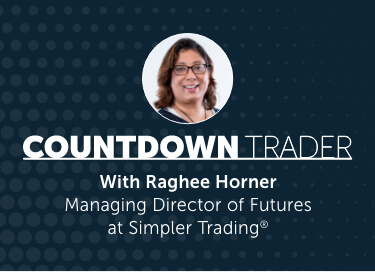Top Stories of the Week
Embracing a day-trading playbook is the best way to keep the pipeline of opportunities full. Consider that overnight or “swing trades” continue to struggle with a lack of follow-through or volatility; the short-term playbook is the one to open. Day trading will be the ideal way to find opportunities for entries, manage risk, and decrease exposure to the macroeconomic uncertainty of the Federal Reserve’s next move.
Day trading focuses on the 9:30 to 4:00 PM ET window of the US trading session, and we focus primarily on options on stocks and ETFs. Futures indices, treasuries, metals, and energies may also be traded in this window.
What is the value of the day trading? First, it is the most liquid and well-participated session for the S&P, NASDAQ, Dow, and Russell. The 9:30 to 4:00 PM ET window also overlaps with the ETF alternatives of these indices, the SPY, QQQ, DIA, and IWM. This, in turn, opens the door to the heavily weighted sectors in each of those indices; all the cylinders are firing actively and with liquidity. Liquidity for options is measured in open interest. It is important not to trade illiquid stocks, ETFs, or strikes.
Why is there such chop, indecision, and volatility in the current market? Despite what seemed to be an uneventful Jackson Hole Symposium appearance from Fed Char Powell on Friday, the Fed Fund futures were steadily increasing the expectation of one more ¼ point hike in either November or December. Remember that was not a “new” expectation but a known one. This presents less surprise or shock to indices, treasuries, and currencies. September’s expectations are for the FOMC to take no action on rates. However, there is now a chance for a hike in November. That expectation is nearly the same as a pause, but this is the most Fed Fund futures have discounted a potential hike for these last two meetings of 2023.
Think of Target Rate Probabilities as the decoder ring for the Federal Reserve. And what this decoder rings is saying is that the macroeconomic picture is far from clear. Notice the current rate 525-550 column is neck and neck with the ¼ hike column, 550-575. This is what the measuring stick for uncertainty looks like.
The rest of the year will be more like August than July. The remainder of the year is very unlikely to behave as July did. Relying on such trends will lead to disappointment. Trading when indices move consistently higher is a gift and not one that will be given often.
The lack of clarity will keep the stock market uncertain enough to chop but likely not break despite non-stop fearmongering and certainly not clear enough to create enough confidence to trigger an uptrend that can maintain higher highs. This is a challenging environment for traders looking for a broader trend – in either direction. However, this is not an untradeable environment if the style is nimble and does not need longer-term, session-after-session follow-through. While this was what was seen in July. Think of July as part mirage, part seasonal trend.
The historical seasonals tell the story.
Click this link to view the Seasonal Trend of the S&P 500 Over 10 Years https://www.screencast.com/t/GAOad3Ze0
Click this link to view the Seasonal Trend of the S&P 500 Over 5 Years https://www.screencast.com/t/znXkU8DRe
Let’s focus on the seasonal Trend of the S&P 500 Over 5 Years. July’s chop transitions into a very choppy month of August. If a month like July is seasonally to appear again, it’s not until early November that it will be organized. Not so coincidentally, the FOMC Meeting for that month is November 1.
Expecting August, September, and October to behave like July will be a painful experience.
The game plan for the rest of the year or until Powell wants to give traders and investors his S&P target. Partly a joke and wishful thinking, it won’t happen that way.
How does a trader rely on the data? First, narrow it down to what matters. Powell will be more hawkish if inflation ticks up. The rate of change of PCE (this Thursday) and CPI will be the data to track. Powell will be forced to pause if unemployment ticks (Initial Claims) up and if jobs (NFP is this Friday, September 1) and job openings (JOLTS) tick down. ISM data and UoM Michigan Inflation Expectations will be important but secondary considerations.
Each of the data events above is one more data point for Powell & Co. to use to justify their decisions and commentary and, ultimately, their decisions on monetary policy.
The current environment plays into the hands of shorter-term time frames and time horizons. When intraday price data is used, and less follow-through is needed after entry, trades can thrive in chop, and investors must be patient.
This Week’s Top Tier Outlook
“Index – Sector – Stock” is the key to trade selection because it is a top-down approach to watchlist building. Adding this approach to a macroeconomic understanding is the clearest path to successful trade setups.
S&P (/ES) 4500 remains elusive, and it’s no wonder: Financials have struggled. For the S&P, financials (XLF) trading back above 34.00 will be the first step. Initial resistance in XLF is waiting at 34.50. This is not the only piece of the puzzle. The S&P (/ESu23) must trade higher through 44.29 by Tuesday. This would all be in addition to healthcare (XLV), at the very least, holding 133. Despite these moves, it will be the willingness of buyers to keep bidding up the S&P past 4500 that will determine follow-through. The sectors are the path there.
NASDAQ (/NQ) Last week, the retracement higher was in focus. The daily time frame traded to the 50% retracement at 15336 and headed lower. It’s not the sell-off that the retracements project but simply resistance. Do not expect a reaction other than a stall; the price has to earn the next leg after any big rally. The August 23 move from 14957.25 to 15356.75 needed bulls to stay interested in levels above the major psychological level of 15400. The August 18 low at 14609.25 will be an important level for buyers to step in at or before. A preoccupation with tech is not warranted, as outlined for weeks. But habits are hard to break, and most traders cannot help but ponder, “When will AAPL bottom”? Break this habit quickly by asking: Is XLK or the QQQ the relative outperformer amongst the indices and sectors, and would it be better to shorten the time frame and time horizon to capitalize on the move? XLK has been far from clear in the market structure, and the August 24 candles, while great for day traders, are a mess for swing traders.
Dow (/YM) The index with the most weighting in financials is the Dow. XLF is the highest weighted sector, and without XLF, the Dow would need technology and healthcare to work overtime to compensate for the XLF. What is promising for bulls is that there was demand at 168, enough to close above this level for the week. The July rally retraced to nearly the 88.6% level at 34036. A close above 34820 still elides the buyers and will be necessary to shore up the bullish sentiment on the daily timeframe.
Energy (XLE) is a wild care sector for the S&P and Dow. The weighting of oil stocks, namely XOM, CVX, SLB, and HAL, keeps XLE and oil services (OIH) resilient.
Russell (/RTY) It’s preferable to intraday or overnight follow-through for the Dow and Russell to move together. When they are in tandem, this reflects that financials (big banks for the Dow, regional banks, KRE, for the Russell) are moving in the same direction. KRE continues to struggle to catch a steady bid and climb higher. It will be important to upside follow-through that KRE remains above 43.87 and does not break below 42.81. The Russell (/RTYu23) has slipped below the 200-period exponential moving average. The index could regain its bullish composure with an early move higher through 1867.2. Trading lower through 1832.8 would reflect that KRE is struggling.
This Week’s Important Hot Zones
All Times Eastern
“Hot Zone is a term I coined in my first book. They are scheduled, high impact, high volatility events that can change the macroeconomic picture.”
- Monday: 10:30 AM Dallas Fed Manufacturing
- Tuesday: 10:00 AM JOLTS
- Wednesday: 8:15 AM ADP Employment Chance, 8:30 AM PCE QoQ, 10:00 AM Pending Home Sales, Collins
- Thursday: 8:30 AM PCE MoM, 10:00 AM FOMC
- Friday: 8:30 AM Non-Farm Payroll
- Wild Card Hot Zone: Not much will eclipse the Friday jobs data. However, Wednesday’s ADP could offer some early fireworks



